Artillery vs Citadel
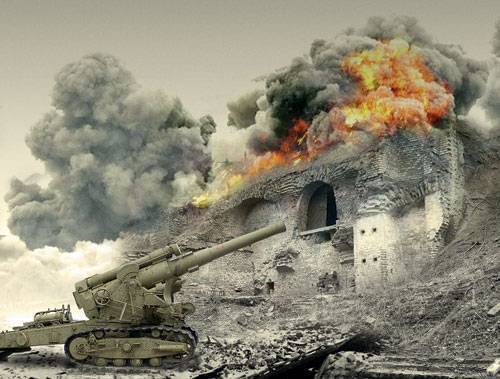
The January offensive of 1945, the troops of the 1 of the Byelorussian and 1 of the Ukrainian Front, launched on the Vistula, went down in history as the Vistula-Oder strategic offensive operation. One of its bright, bloody and dramatic pages was the liquidation of a group of German troops surrounded in the fortress city of Poznan.
The German command tried to use the city and the strongest fortress “Citadel” in engineering, in order to constrain the actions of our troops and to delay their advance in the Berlin direction. Adapting the fortress to the tactics of modern warfare, the German military experts on tank-dangerous directions around the city dug anti-tank ditches, created field firing positions with the calculation of lumbago of roads and approaches to anti-tank ditches. Along the roads, the enemy equipped the firing points located in staggered order. They were installed anti-tank guns and machine guns. All field structures were connected by a common system of fire with fortresses located around the city.
The fort was an underground structure that almost did not protrude above the ground level. Each fort was surrounded by a moat of width 10 m and a depth of up to 3 m with brick walls - they had loopholes for frontal and flank attacks. The forts had an overlap of up to one meter thick and were covered with an earth embankment up to 4 m thick. Inside the forts there were dormitories for garrisons, from platoon to battalion, vaulted worn with a number of pockets to place ammunition, food and other property. All the forts were equipped with artesian wells and appliances for heating and lighting.
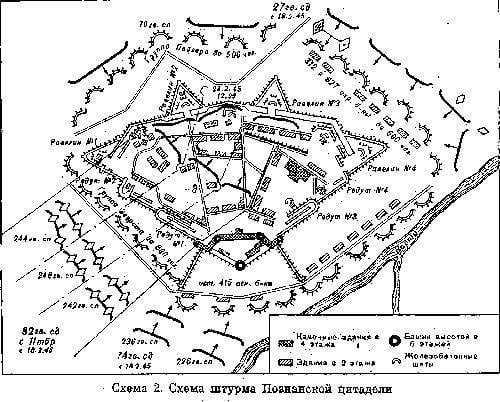
Construction of the fortress of Poznan began in the year 1828. At that time the city was under the control of Prussia, which Poznan inherited after the second partition of Poland (1793)
Volleys thousands of guns
It should be noted that German military specialists not only largely adopted the experience of building long-term defensive structures such as the Finnish line of Mannerheim or the French Maginot line, but also brought their own changes in accordance with the new combat conditions. Soviet troops, and in particular artillery, faced the difficult task of destroying the fortress city of Poznan and its garrison as soon as possible. In this connection, the memoirs of the artillery commander of the 1 of the Belorussian Front V.I. Kazakov and the memoirs of the hero of the Battle of Stalingrad of the commander of 8-th Guards Army V.I. Chuikov. It was under their leadership that the Soviet troops conducted a bloody assault on Poznan.
The liquidation of the surrounded group was assigned to the 29 th Guards and 91 th rifle corps, which received reinforcement. In total, the 1 troops of the Byelorussian Front, attracted for the assault, had about 1400 guns, mortars and rocket artillery combat vehicles, including over 1200 caliber units from 76 mm and above. In view of the powerful defenses of the German garrison of Poznan, the decisive role in the assault on the fortress was given precisely to cannons, howitzers and mortars. The artillery of the reserve of the main command was divided into two powerful groups: the north and the south.
Looking ahead, we say that the assault on Poznan was difficult and was accompanied by serious losses for the attackers. Even V.I. Kazakov noted in his memoirs that "these were long, stubborn and exhausting battles, where every building had to be taken with a fight."
Caliber is too small
The assault on the city by Soviet troops began on January 26, 1945, but this day did not bring success. The next day, the units of VI Chuikov began storming the forts in front of the citadel. Artillery 3 – 5-minute fire raids overwhelmed manpower and fire weapons in the forts until the infantrymen passed between them and blocked them. Such a construction of artillery support of the attack required high accuracy in the preparation of the initial data and in the adjustment of firing. Unfortunately, sometimes these calculations turned out to be not quite correct and the infantrymen got their hands on their own shells.
Initially, the attempts to capture the forts failed, although the attacking infantry was given instruments of support and Tanks. One such unsuccessful example is written in the memoirs of V.I. Chuikova "The End of the Third Reich." The battle for Fort Bonin was led by an assault group, which included an incomplete rifle company, a 82-mm mortar company, a sapper company, a smoke chemist’s department, two T-34 tanks and a 152-mm gun battery. After the artillery processing of the fort, an assault group, under cover of a smoke screen, burst into the main entrance. She managed to take possession of two central gates and one of the casemates that covered the approach to these gates. The enemy, having opened strong gun and machine-gun fire from other casemates and also using faustpatrons and grenades, repelled the attack. After analyzing the actions of the attackers, V.I. Chuikov understood their mistakes: “It turned out that the fort was stormed only from the side of the main entrance, not constraining the enemy from other directions. This allowed him to concentrate all his strength and all the fire in one place. In addition, practice has shown that for assaulting forts, the caliber of 152 mm guns is clearly insufficient. ”
All these reasons for failure were taken into account in the subsequent attack. It began after the fort was treated with heavy cannons firing concrete-concrete shells. The assault group approached the enemy from three directions. Artillery and during the assault did not cease fire on embrasures and surviving firing points. After a short struggle, the enemy capitulated. Such an organization of the actions of artillery in the seizure of blocked forts securely ensured the unimpeded advance of our infantry. As a result of January 27, 1945, all three forts were captured. Fighting began in the neighborhoods of the city. Day after day, slowly and stubbornly, the units of the V.I. Chuikov cleaned the house behind the house.
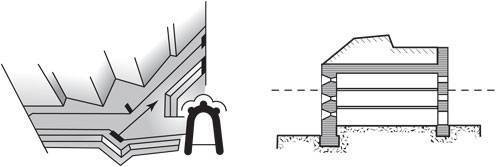
Terrible Pentagon
In conducting street fighting in Poznan, Soviet artillery supported the actions of the assault groups. As a rule, the assault group consisted of an infantry battalion reinforced with 3 – 7 caliber guns from 76 to 122 mm. Usually the day began with a short artillery preparation, which lasted no more than 15 minutes. Shot all the artillery. From closed positions, the fire was fired at the depth of the enemy's defenses, and then the actions of the assault groups began, which were supported by guns firing direct fire.
By mid-February, Soviet troops captured the city of Poznan, with the exception of the citadel. It was a pentagon of irregular shape and was located in the northeastern part of the city. The walls and ceilings of the citadel reached 2. In each corner there were fortifications - redoubts and ravelins. Inside the fortress there was a number of underground rooms and galleries, one-story and two-story buildings for warehouses and shelters.
Along the perimeter of the citadel was surrounded by a moat and earthen shaft. The walls of the moat height 5 – 8 m were lined with bricks and proved to be insurmountable for tanks. Of the numerous loopholes and embrasures arranged in the walls of buildings, towers, redoubts and ravelins, all the faces of the moat and the approaches to it were shot by both frontal and flanking fire. In the citadel itself, around 12 000, German soldiers and officers led by two commandants, the former commandant, General Mattern and General Connel, were hiding.
The main attack on the fortress inflicted two rifle divisions from the south. To ensure the capture of the fortress, four cannon and howitzer brigades, three artillery and mortar battalions, one of them of special power, were supplied. 236 shells and mortars of caliber up to and including 203 and 280 mm were concentrated on a section less than a kilometer wide. 49 guns stood out for direct fire, including five 152-mm howitzers-guns and twenty-two 203-mm howitzers.
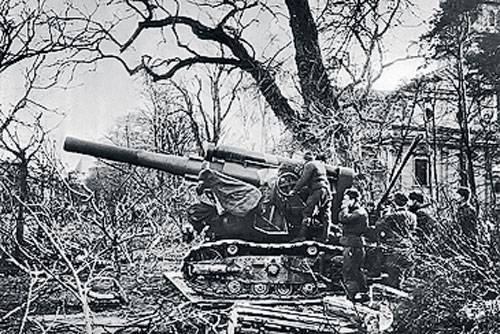
Concrete argument
The destruction of the most important objects of the fortress began 9 February 1945, with the approach of artillery large and special power, which is usually made 152-mm cannon Br-2 and 203-mm howitzer B-4. The shells of these guns made it possible to punch concrete floors with a thickness of 1m. In addition to them, the Red Army had 280-mm mortars of Br-5 of model 1939 of the year. The armor-piercing shell of this mortar weighed 246 kg and could pierce a concrete wall up to 2 m thick. The effectiveness of such guns in the battles for Poznan was very high.
February 18 was made a powerful artillery strike on the citadel. 1400 guns and rocket launchers "Katyusha" ironed the German defense for four hours. After that, Soviet assault groups broke into the destroyed buildings of the fortress. If the enemy continued to resist in any place, then 203-millimeter howitzers were urgently pulled up to him. They began to beat direct fire on the fortified positions of the enemy, until they destroyed them completely.
The heat of struggle and bitterness in the battles for the citadel were incredible. And here the Soviet artillerymen more than once rescued their ingenuity and good interaction with other branches of the military. This is evidenced by the following characteristic episode described in the memoirs of V.I. Kazakov. 20 February 1945, the assault groups of the 74 Guards Division, covered with well-aimed artillery fire, seized a section of the rampart between fortifications No. 1 and 2. On the eve of the gunners made a breach in the fortress wall, through which a unit of Soviet infantrymen broke into the fortifications No. 2. However, there the attackers had to tight, as the Germans were at them accurate and accurate fire. It became clear that the Soviet infantry could not advance further without the aid of artillery. The commander of the 86-th separate anti-tank division, Major Repin, was ordered to quickly transfer guns to the support of the infantry. The gunners managed to roll one 76-millimeter and one 45-millimeter gun on the assault bridge, but it was impossible to overcome the distance between the bridge and the fortress wall because of strong enemy fire. This is where ingenuity came in handy. As V.I. Kazakov writes, “the gunners secured one end of the rope to the base of the 45-millimeter cannon and, clutching at the other end of the rope, crawled under fire to the wall. Hiding behind it, they began to drag the gun, and when they pulled it up to the wall, they opened fire on the firing points located inside the fortress. Now it became possible to roll out the 76-millimeter cannon through the breach inside the courtyard and open fire at the entrance to the fortification No. XXUMX. ” The flamethrower Serbaladze took advantage of these resourceful actions of the artillerymen. He crawled to the entrance to the fortification and from the backpack flamethrower launched one after another two fiery streams. As a result, a fire broke out, then the ammunition was detonated inside the fortifications. Thus the fortification No. 2 was eliminated.
The path to Berlin is open
Another example of soldier's ingenuity was the creation of the so-called RS assault groups, which fired single direct-impact rockets directly from the closure. The M-31 projectile was packed and secured on the window sill or in the wall break where the firing position was selected. The M-31 projectile pierced a brick wall 80 cm thick and broke inside the building. To attach the guides M-20 and M-13 used tripods from captured German machine guns.
Evaluating the effect of applying this weapons in the battles for Poznan, VI Kazakov noted that "only 38 was fired at such shells, but with their help they managed to drive the fascists out of 11 buildings." Subsequently, the creation of RS groups was widely practiced and fully justified itself in the battles for the capital of the Third Reich - Berlin (see the article by A. Isaev “Technique in the battles for Berlin”, “PM” No. XXUMX'5).
As a result, with great difficulty overcoming the desperate resistance of the German garrison, the Soviet troops to 23 in February 1945, captured the citadel and completely liberated the city of Poznan. Note that, despite the almost hopeless situation, the German garrison of Poznan resisted to the last and could not resist only after the massive use of large and special power by artillery by the Soviet troops. Moscow celebrated the day of the Red Army and the capture of Poznan with a salute, firing 20 volleys from 224 guns.
In conclusion, it should be said that in the Vistula-Oder operation the long process of finding the best forms and methods of controlling the fire and maneuver of large masses of artillery was completed. In the course of the battles for Poznan, tactics of field and rocket artillery actions in urban environments were made up of assault groups, large-scale and special power artillery actions against the enemy’s long-term fortifications, as well as other methods of fighting in urban environments. The capture of Poznan was, without a doubt, the dress rehearsal for the storming of the capital of the Third Reich.
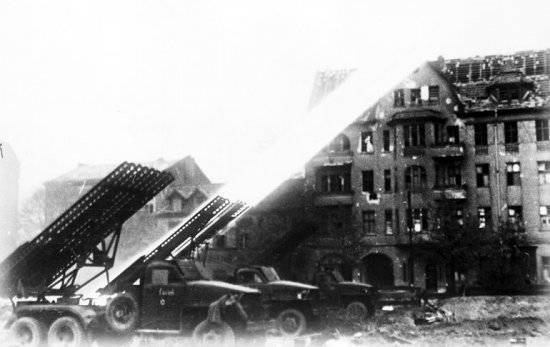
Information